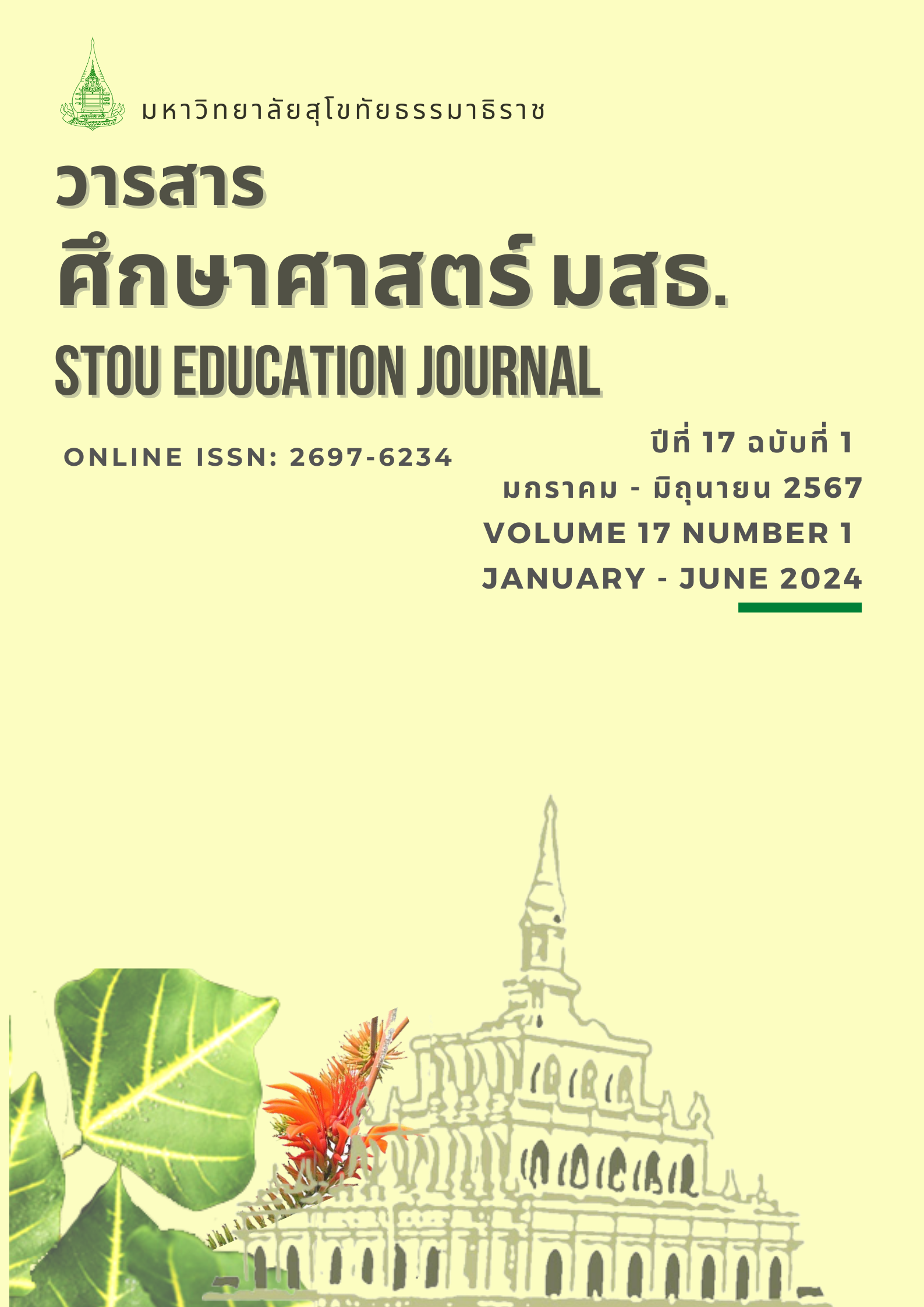The Development of Innovative Thinking Skill and Collaborative Problem Solving Competency by Using STEM Innovation Learning Approach in the Topic of Plant of Grade 11 Students at Pluakdaeng Pittayakom School, Rayong Province
Main Article Content
Abstract
The purposes of this action research were to: 1) develop innovative thinking skills and collaborative problem solving competency of grade 11 students at Pluakdaeng Pittayakom school learning through the STEM innovation learning approach in the topic of plants, and 2) study the best practices of learning management in the STEM innovation learning approach, which fosters both innovative thinking skills and collaborative problem solving competency. The study group comprised 41 students from Pluakdaeng Pittayakom school selected through purposive sampling. The employed research instruments were the STEM innovation learning approach lesson plans, an innovative thinking skill assessment form, a student innovation work evaluation form, a collaborative problem solving competency assessment form, a collaborative problem solving performance observation form, and learning logs from teachers and students. Data underwent analysis using frequency, percentage and inductive analysis. The research findings revealed that: 1) throughout each operational cycle, all students exhibited a higher level of innovative thinking skills and collaborative problem solving competency development. In the third cycle, 36 students (87.8%) displayed a high degree of innovative thinking skills and all students showcased a high level of performance in collaborative problem-solving competency, and 2) the best practices relating to the learning management approach, include: (1) selecting problem situations aligned with students' prior experiences and learning objectives to enhance their problem identification skills, (2) incorporating motivational questions during the design phase to facilitate the creation of more successful products, and (3) establishing a shared understanding of presentation and assessment objectives among groups, leading to improved work quality.
Article Details
References
ชนะชัย ทะยอม. (2560). การวิจัยปฏิบัติการเพื่อพัฒนาสมรรนถะการแก้ปัญหาแบบร่วมมือโดยใช้รูปแบบการเรียนรู้แบบเสริมต่อการเรียนรู้บนฐานของการใช้ปัญหาเป็นฐาน เรื่อง ปริมาณสารสัมพันธ์ สำหรับนักเรียนชั้นมัธยมศึกษาปีที่ 4 ห้องเรียนพิเศษวิทยาศาสตร์. วารสารวิทยบริการมหาวิทยาลัยสงขลานครินทร์, 28(2), 34-45.
ชาญณรงค์ วิเศษสัตย์ และ ประสาท เนืองเฉลิม. (2562). แนวทางการจัดการเรียนรู้ ส่งเสริมทักษะการคิดเชินวัตกรรมของนักศึกษาวิชาชีพครู. วารสารบริหารการศึกษาบัณฑิต มหาวิทยาลัยราชภัฏอุบลราชธานี, 18(4), 129-141.
ทิศนา แขมมณี. (2559). ศาสตร์การสอน องค์ความรู้เพื่อการจัดกระบวนการเรียนรู้ที่มีประสิทธิภาพ (พิมพ์ครั้งที่ 20).สำนักพิมพ์แห่งจุฬาลงกรณ์มหาวิทยาลัย.
ทิศนา แขมมณี. (2561). ศาสตร์การสอน องค์ความรู้เพื่อการจัดกระบวนการเรียนรู้ที่มีประสิทธิภาพ (พิมพ์ครั้งที่ 21). สำนักพิมพ์แห่งจุฬาลงกรณ์มหาวิทยาลัย.
นวลน้อย บุญวงศ์. (2539). หลักการออกแบบ. สำนักพิมพ์โอเดียนสโตร์.
พรทิพย์ ศิริภัทราชัย. (2556). STEM Education กับการพัฒนาทักษะในศตวรรษที่ 21. วารสารนักบริหาร, 33(2), 49-56.
สถาบันส่งเสริมการสอนวิทยาศาสตร์และเทคโนโลยี [สสวท.]. (2557). ความรู้เบื้องต้นสะเต็ม. สถาบันส่งเสริมการสอนวิทยาศาสตร์และเทคโนโลยี.
สถาบันส่งเสริมการสอนวิทยาศาสตร์และเทคโนโลยี [สสวท.]. (2563). PISA 2015 ผลการประเมินการแก้ปัญหาแบบร่วมมือ (collaborative problem solving). สสวท.
สายชล สุกร. (2561). การพัฒนาสมรรถนะการแก้ปัญหาแบบร่วมมือของนักเรียนชั้นมัธยมศึกษาปีที่ 6 ด้วยการจัดการเรียนรู้ตามแนวคิดสะเต็มศึกษาโดยใช้ปัญหาเป็นฐาน เรื่อง พอลิเมอร์. วารสารศึกษาศาสตร์มหาวิทยาลัยบูรพา, 30(2), 166-181.
สิรินภา กิจเกื้อกูล. (2558). สะเต็มศึกษา. วารสารศึกษาศาสตร์ มหาวิทยาลัยนเรศวร, 17(2), 28-38.
สุภาภรณ์ บัวผัด. (2562). รายงานการวิจัย เรื่อง การใช้วิธีคิดเชิงออกแบบ (Design Thinking) เพื่อพัฒนาระบบการโค้ชนิสิตในการทำกิจกรรม: กรณีศึกษา การสร้างทีมนิสิตทุนให้มีทักษะการเป็นผู้ประกอบการ (Entrepreneurship). https://dsa.up.ac.th/public/file_upload/news/ATTACHED_FILE/1661730223.pdf
อนุรักษ์ เร่งรัด. (2565). การศึกษาแนวทางการจัดการเรียนรู้ที่ส่งเสริมสร้างทักษะการคิดเชิงนวัตกรรมสำหรับนักเรียนระดับชั้นมัธยมศึกษาตอนต้น. วารสารมนุษย์ศาสตร์และสังคมศาสตร์ มหาวิทยาลัยนครพนม, 12(3), 338-354.
Antonenko, P. D., Hudson, G., Townsend, R., & Pritchard, J. (2011). DEEPER e-learning with environment for collaborative learning integrating problem solving experience (ECLIPSE). In Proceedings of World Conference on E-Learning in Corporate, Government, Healthcare, and Higher Education 2011 Australian.
Capraro, R. M., Capraro, M. M., & Morgan, J. R. (2013). STEM project-based learning. Sense Publishers.
Carroll, M., Goldman, S., Britos, L., Koh, J., Royalty, A., & Hornstein, M. (2010). Destination, imagination and the fires within: Design thinking in a middle school classroom. International Journal of Art and Design Education, 29(1), 37-53.
Gunzelmann, G., & Anderson, J. R. (2003). Problem solving: Increased planning with practice. Cognitive Systems Research, 4(1), 57-76
Horth, D., & Buchner, D. (2009). Innovation leadership: How to use innovation to lead effectively, work collaboratively and drive results. http://www.ccl.org.
Kemmis, S., & McTaggart, R. (1988). The action research planer (3rd ed.). Deakin University.
Organization for Economic Co-operation and Development [OECD]. (2013). PISA 2015 Draft Collaborative Problem-Solving Framework. OECD.
Roonghuaphai, R., Chamchuri, D., Poonsuwan, S., &
Yoonisil, W. (2015). Development of measurement a development of learning management plan for encouraging collaborative competencies for primary students. Journal of Educational Research Faculty of Education, Srinakharinwirot University, 9(1), 109-116.
The Standford D. school Bootcamp Bootleg [HPI]. (2010). An introduction to design thinking process guide. https://dschool-old.stanford.edu/sandbox/groups/designresources/wiki/36873/attachments/74b3d/ModeGuideBOOTCAMP2010L.pdf
Weiss, D. S., & Legrand, C. (2011). Innovative intelligence: The art and practice of leading sustainable innovation in your organization. John Wiley & Sons.


